Employee engagement is integral to just about every process in your business. And to keep track of it, you’ll need the help of quality employee engagement surveys.
According to Gallup, only 31% of employees report feeling engaged in the organization. Meanwhile, disengaged employees cost companies around the globe upwards of $500 billion dollars annually.
These jarring statistics call upon employers to monitor employee engagement more closely and consistently. An employee engagement survey lets you do just that. But to get effective employee feedback, you’ll need to get a better understanding of how to plan, publish, and promote an effective employee engagement survey.
What is an Employee Engagement Survey?
An employee engagement survey is a questionnaire that measures how invested and motivated employees feel in your organization. They are an example of asynchronous communications, as they are sent at various, non-recurring times over the year.
Typically, employees answer a series of questions related to employee experience, morale, and employee happiness metrics. This data then goes off to managers and executives who assess what the insights are telling them.
If employee engagement levels are low, managers need to act on employee suggestions to make tangible improvements. If engagement levels are high, you’ll need to determine what factors positively impact engagement and emulate those actions.
Boost participation in your employee engagement surveys with ContactMonkey’s pulse survey tool. By allowing you to embed quick, simple surveys into your internal emails, ContactMonkey makes it easy to motivate employees to complete your questionnaire.
Learn how to create engaging pulse surveys with our step-by-step guide.
What is The Purpose of an Employee Engagement Survey?
The goal of an employee engagement survey is to alert you to issues in workplace engagement while opening up communication channels with employees. Your team gains actionable insights that you can use to respond to engagement issues.
Your survey results can pinpoint problems relating to specific roles, teams, or departments. Over time, it becomes easy to take stock of response data and compare results to monitor employee engagement statistics and workforce analytics. You’ll see if certain employee engagement strategies and employee engagement models that you’ve put in place are actually working.
At the same time, by consistently asking employees for engagement feedback, you’re strengthening workplace communication channels.
What are the Key Goals of Employee Engagement Surveys?
The key goals of your employee engagement survey should always be:
- Monitoring employee engagement trends
- Gathering staff suggestions for improving employee engagement
- Strengthening two-way communication
- Fostering a culture of feedback across your organization
Why Conduct an Employee Engagement Survey?
Employee engagement surveys take a “pulse” of employee sentiment across your organization. This is essential for understanding what areas of digital employee experience you may be overlooking, and what organizational strengths you have to leverage.
For those wondering “Do employee engagement surveys really work?” here are just a few of the impressive benefits of employee engagement surveys:
- Reveals whether you need to improve employee morale and helps you determine what makes employees happy and what doesn’t.
- Gives a voice to your employees and allows them to express their opinions, concerns, and suggestions, which ultimately improves two-way communication.
- Provides you with actionable data for improving employee engagement.
- Promotes business growth by enabling employees to highlight areas of the business where you can make improvements.
What do Employee Engagement Surveys Measure?
Employee engagement surveys measure the prevalence of a range of factors that influence workplace engagement. These are often known as “employee engagement drivers.”
Since employee engagement is so difficult to pin down, identifying and measuring its key drivers makes it easier to analyze workplace engagement.
Most notably, employee engagement drivers include company culture, compensation and benefits, and employee recognition. But there are countless other employee engagement drivers to keep in mind.
For their part, employee engagement surveys try to quantify and qualify how employees feel in relation to these various drivers of employee engagement. With this data in hand, it becomes easier to understand and improve employee engagement.
Disadvantages of Employee Engagement Surveys
While conducting employee engagement surveys is always beneficial, they can present a few challenges. The main reason for this is that employee engagement itself is a difficult concept to pin down.
Rooted in emotion and mental state, employee engagement isn’t easy to calculate. Surveys that strive to simply quantify employee engagement often lead to a dead end.
That being said, using a combination of closed-ended and open-ended employee engagement survey questions can help avoid the pitfalls of conducting these types of surveys.
With ContactMonkey, users have a range of pulse survey options to choose from, making it easier to get accurate employee engagement data. Employees can respond to survey questions using anonymous comments as well as likert and dichotomous scales.
You can even embed Employee Net Promoter survey questions which gather quantitative employee engagement insights using a numerical scale and a single, pointed question:
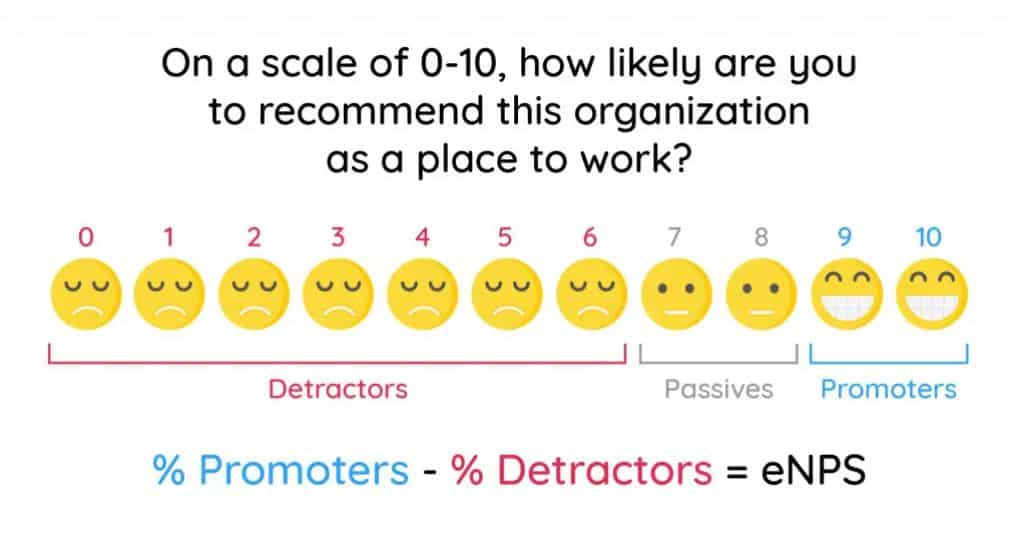
Employee Engagement Survey Best Practices
Before you begin brainstorming your staff survey questions, it’s important to understand employee engagement survey best practices. These will help keep your survey focused, generate more engagement, and make it easier to analyze survey response data.
1. Keep employee engagement surveys short and straightforward
Research shows that data quality declines on surveys that are longer than 10 minutes. So keeping surveys short and simple is the key to encouraging participation. Questions should not take up more than one or two sentences. They should be focused and directly relevant to the audience that you’re surveying. We also recommend starting with actionable words, such as “Comment,” “Rate,” and “Evaluate” to keep things direct and straightforward.
2. Make it a consistent effort
Employee engagement levels can shift quickly. So it’s important to survey employees consistently—without being overbearing. With ContactMonkey’s pulse surveys, it’s easy to stick to this rule. Pulse surveys are short, simple, and straightforward. They can be embedded into any employee email. So it’s simple to pop in a few engagement questions at the end of your weekly newsletter and keep things consistent.
If you’re having a hard time thinking of new employee survey questions, ContactMonkey’s OpenAI integration can help you generate content on demand straight form your newsletter builder.
3. Ensure that employee engagement surveys are easy to access
The easier it is for your employees to find, open, and complete your employee engagement surveys, the more likely they are to participate. A pulse survey tool like ContactMonkey makes it easy to ensure accessibility. Our email template builder lets you add surveys directly into internal emails—where you already have a captive audience.
4. Gather a variety of employee survey data
When it comes to engagement surveys, gathering a wide range of response data is crucial. The subjective nature of employee engagement makes it important for employees to express how they feel in their own words.
Open-ended questions and comment options are vital. But there also needs to be some numerical data to support the verbal cues. As such, having a variety of employee survey response options is the best way to go.
Use ContactMonkey’s pulse survey tool to choose from dozens of survey options—from star ratings to emoji reactions.
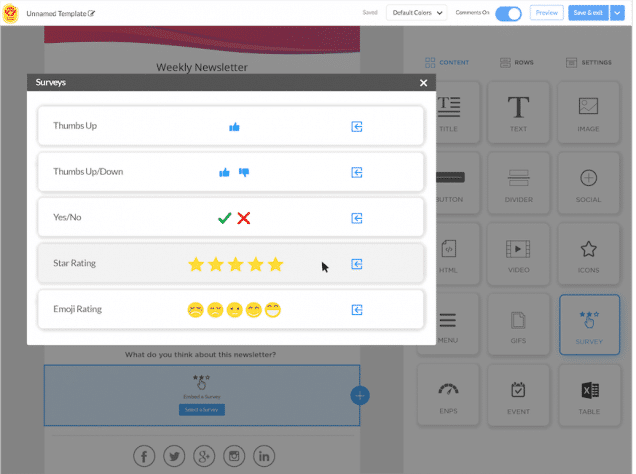
5. Collect anonymous feedback
If you’re wondering, “Should Employee Engagement surveys be anonymous?” the answer is a definite “Yes!” Telling your employer that you’re not sufficiently engaged at work can be awkward at best.
Anonymous feedback helps employees feel more comfortable providing honest and authentic feedback. With ContactMonkey’s internal communications tool, you can embed anonymous comment boxes into any internal newsletter. So employees feel more confident and comfortable sharing their thoughts.
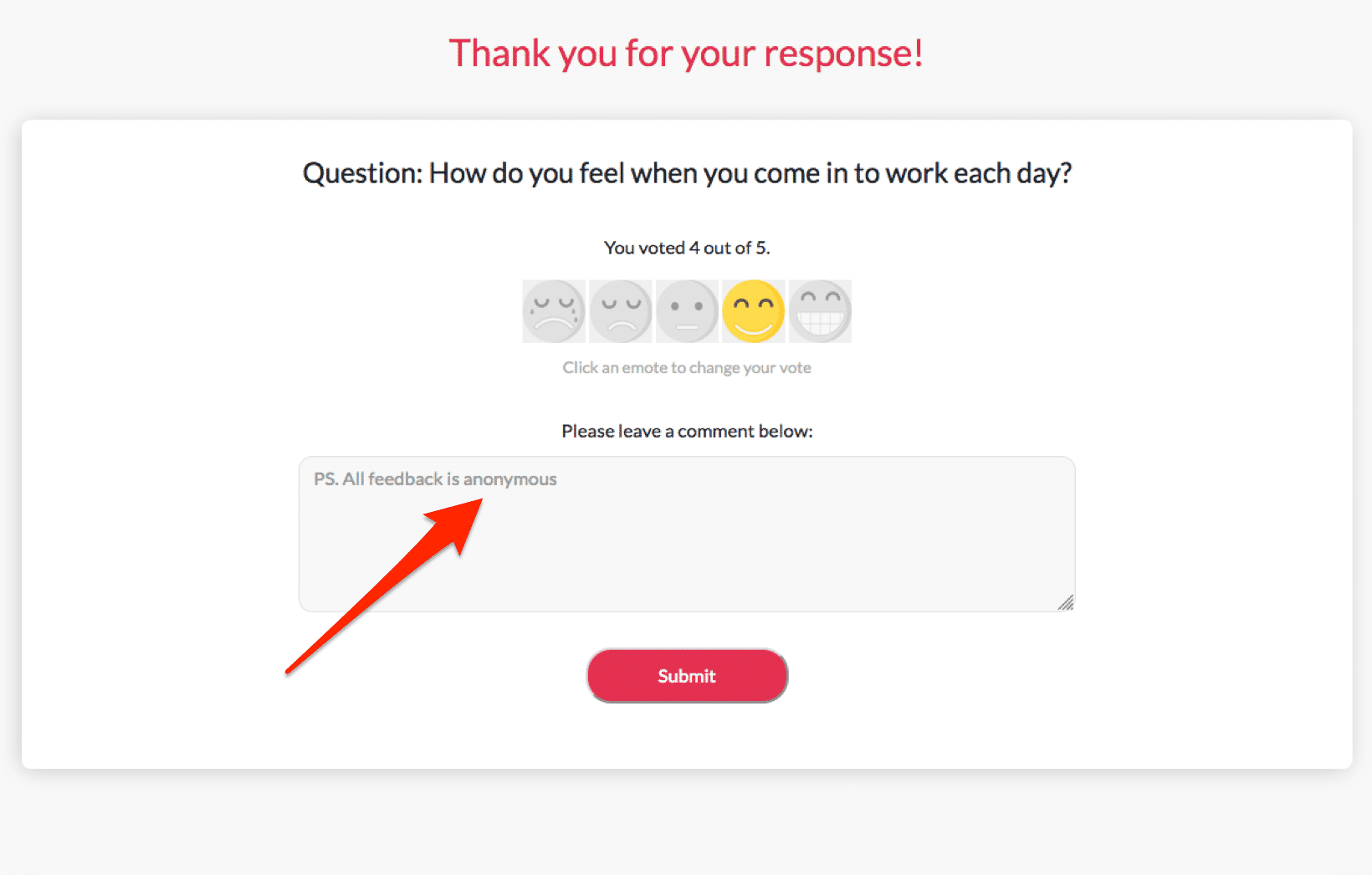
Types of Employee Surveys
Employee engagement surveys are just one of many types of surveys that you can conduct in the workplace. However, the topic of employee engagement is a common thread across almost each and every type of workplace survey.
Why? Because employee engagement determines the success of everything from job satisfaction, to workplace culture and employee retention. Here are just a few other types of employee surveys that touch upon employee engagement:
- Employee wellness surveys
- Company culture surveys
- Employee satisfaction surveys
- Workplace safety surveys
- Employee exit surveys
- Employee benefits surveys
- Job satisfaction surveys
- Change management pulse survey
- Employee motivation survey
- Employee opinion survey
- Fun employee survey questions
- Employee onboarding survey
Best Employee Engagement Survey Questions to Ask
Your employee engagement survey questions determine the reliability and usability of your survey data.
Asking the right questions means touching on key employee engagement drivers, such as team alignment, health and wellness, and trust in leadership. But you also need to look beyond the content of your questions and think about how to present them in a clear and engaging way.
Below, we break down a few employee engagement survey question examples to get you started. We also provide employee engagement survey templates that you can use as inspiration. With ContactMonkey, you can even embed these surveys into Outlook or Gmail newsletters, which you can send instantly and en-masse via Google groups email.
Want to make beautiful newsletters faster? Learn how to create employee newsletters that stand out with our simple guide.
Management questions
Employees usually interact with their direct managers more than with anyone else on the team. So it’s little surprise that this relationship has a big impact on employee engagement. Try asking some of these questions in your next employee engagement survey to see how employees feel about management:
- How satisfied are you with your management team overall?
- Do you regularly receive constructive feedback from your manager?
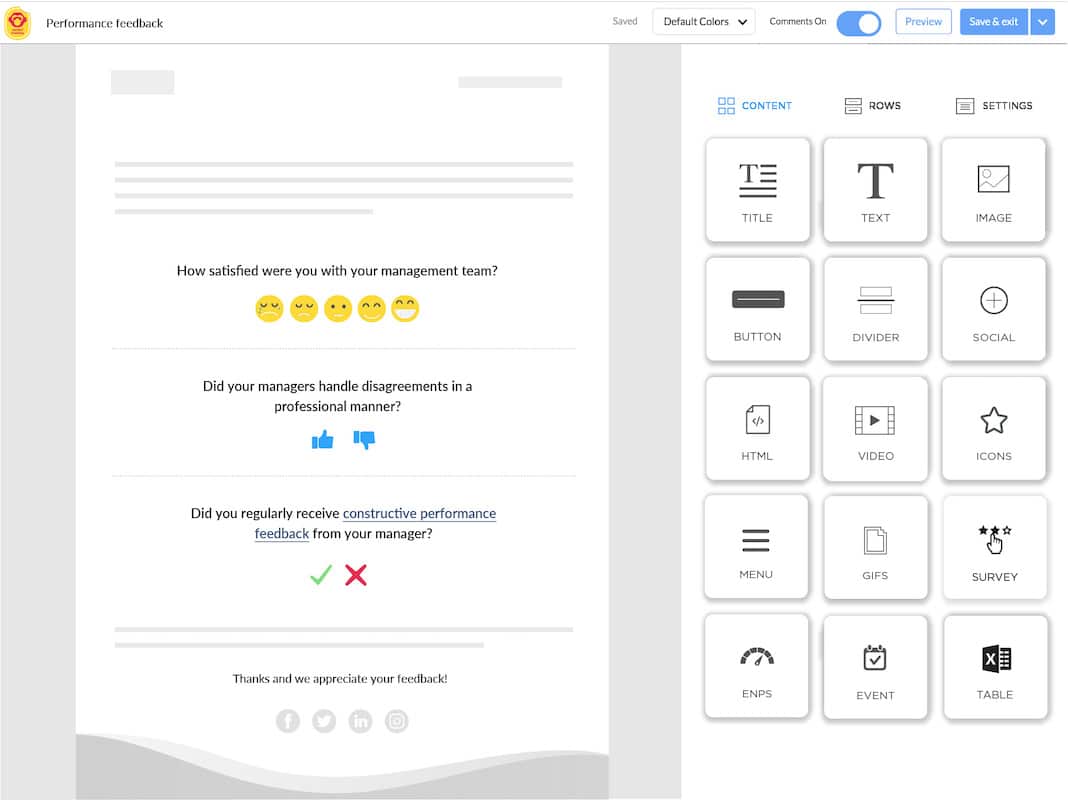
Work/life balance questions
Employee wellness is a major driver of employee engagement. When employees feel stressed and exhausted, they just want to get their work done and go home. Engaging in other areas of the organization falls low on the priority list. To improve work/life balance, consider implementing these questions in your next employee engagement survey:
- Rate your work/life balance (star ratings).
- Do you feel that you’re able to balance your personal and family life with your job responsibilities (yes/no)?
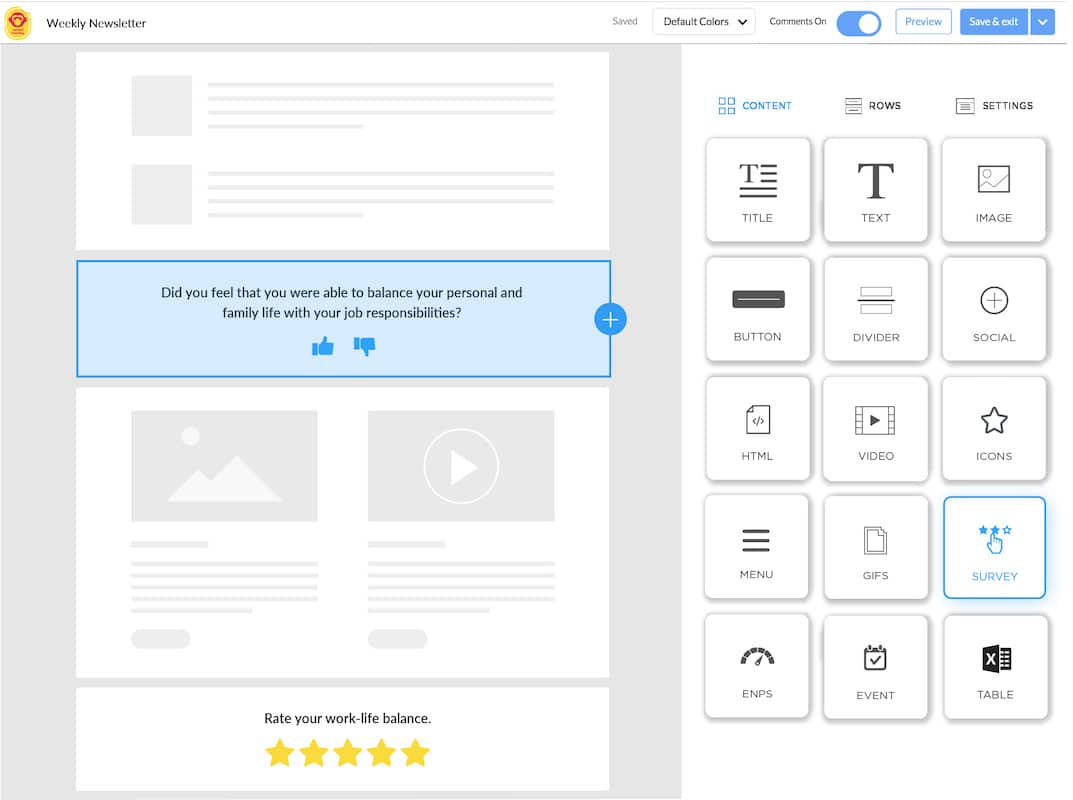
Company culture questions
When there’s a supportive and welcoming corporate culture, grounded in company values, it’s easier for employees to stay motivated. They know exactly how their job relates to the company vision and have a supportive team by their side. Consider asking these company culture survey questions in your next employee engagement questionnaire:
- Rate how well you get along with your team members (star ratings).
- How do you feel when you come in to work each day (emoji reaction + anonymous comment)?
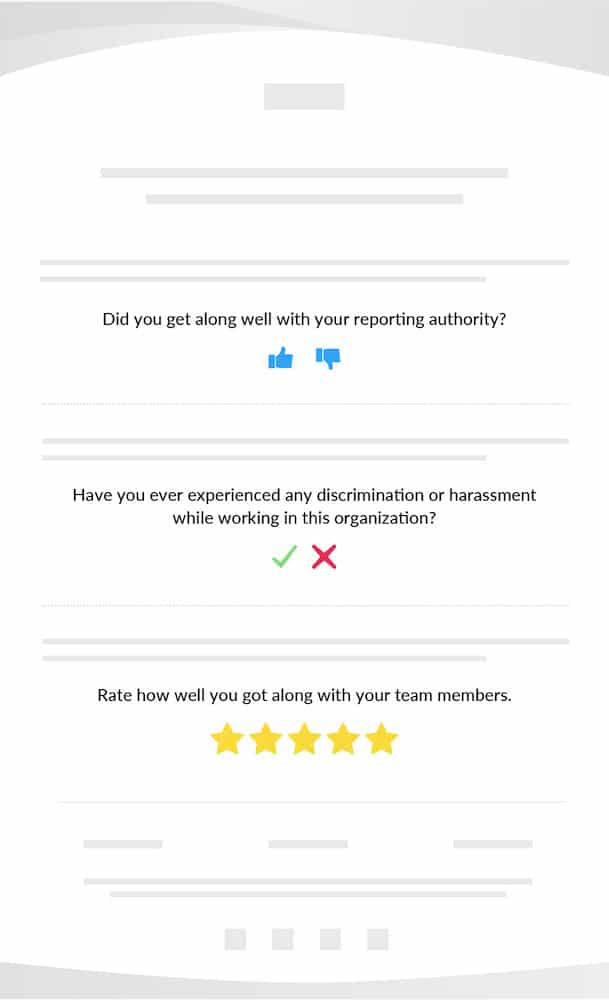
Professional development and employee coaching questions
When employees feel that their job is a dead end, it’s hard to become motivated and engaged. On the other hand, companies that offer professional development and employee coaching opportunities are much more likely to engage and retain staff. With this in mind, we recommend adding some of these questions to your employee engagement surveys:
- Rate the selection of professional development opportunities available to you (star ratings).
- Do you feel that you are given sufficient training and resources to perform well at your job?
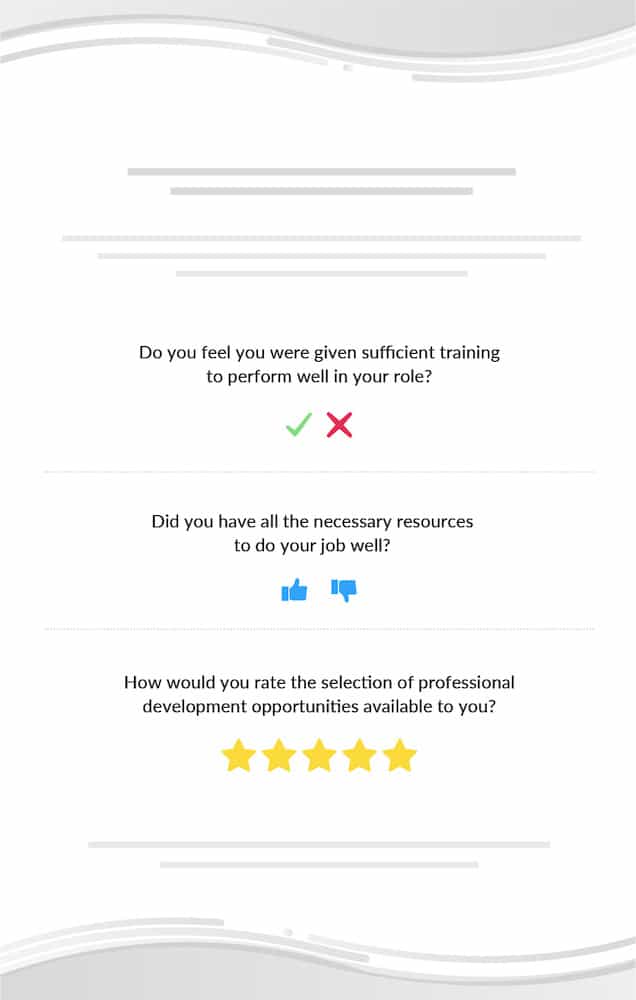
Employee exit survey questions
Losing a valuable employee is always difficult. But it’s also a vital opportunity to understand employee engagement issues in your organization and fix them. This way, you can troubleshoot problems and prevent them from impacting employee turnover long-term. Here are a few exit survey questions that can help you gather employee engagement insights:
- Would you ever consider working for this company again? Why or why not (yes/no response and anonymous comment)?
- Is there a specific problem that led to your resignation (yes/no and anonymous comment)?
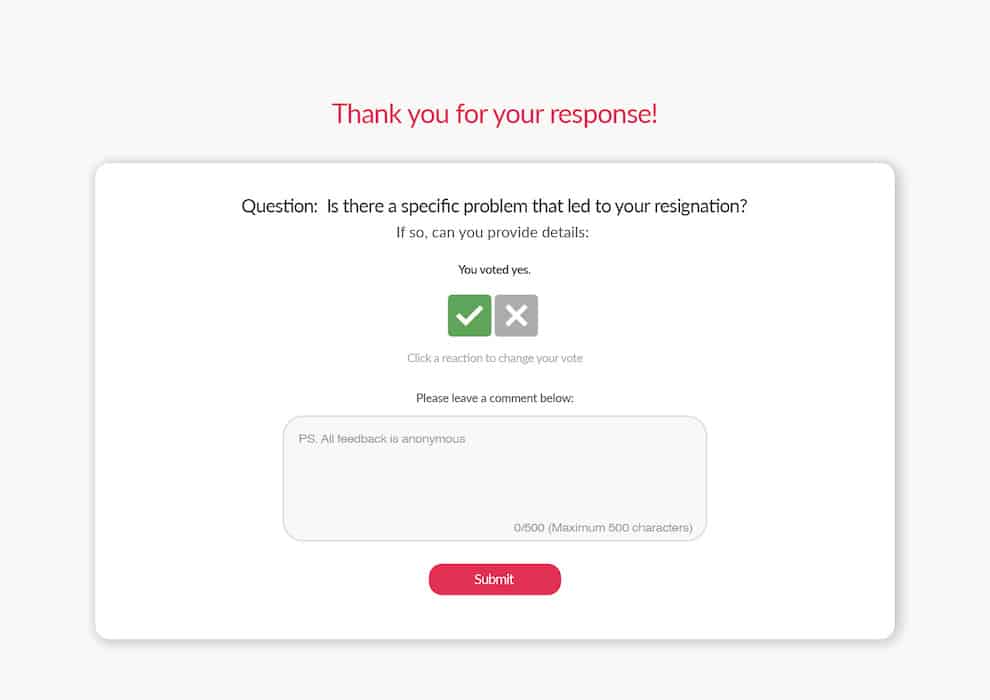
Employee Engagement Survey Software
Choosing the right employee engagement survey software is imperative. The faster you can gather employee engagement data, the quicker you can start acting on it. Not to mention, some survey software helps you visualize data in a more clear and structured fashion, so it’s easier to interpret findings.
Common employee engagement survey features include, anonymous questionnaires, ratings, and employee net promoter score (eNPS).
Check out our blog on employee feedback tools for a full breakdown of the different types of software that can simplify your employee engagement survey.
Use ContactMonkey’s employee engagement survey software to develop a data-based approach to employee engagement. See ContactMonkey in action by booking a Free demo today.
How to Conduct Employee Engagement Surveys
To design an effective employee engagement survey, you’ll need to focus on three core components: survey design, survey questions, and survey themes. Let’s break down the process step by step.
1. Think through your survey design
Your survey design should take into consideration the type of data you want to collect, your survey audience, and available survey methods.
Survey data can include long-form responses, multiple choice answers, and poll ratings. Determine what sort of data would be easiest for your team to collect and decipher. Make sure to take into consideration the length of your survey. Shorter surveys will generate more engagement.
Survey audiences should determine the communication channels you choose for your survey and the tone you adopt. Do you want to survey your workforce as a whole? Or are you looking to get feedback from specific groups or departments? Once you answer this, you can move on to the next step.
Survey methods and structure should take into consideration your audience preferences. If you’re targeting your workforce as a whole, your employee newsletter is the way to go as it reaches the greatest number of employees. If you want to ask a specific team or group, send personalized emails with the survey, or share it via a designated Slack group.
2. Brainstorm employee survey questions to ask your employees
Employee engagement survey questions should be able to both pinpoint problems and identify areas of opportunity. In other words, your questions need to find out what you might be doing wrong, but also what you’re doing right. This way, you can build on existing success.
Key topics to cover in your employee engagement survey include:
Employee retention: these questions should determine whether employees see a future at your company and whether they’d recommend your company to others.
Leadership: because leadership communications have such a big impact on employee engagement, it’s important to have questions that exclusively focus on this area. Ask employees to evaluate their relationships with managers and how they feel about their workload and responsibilities.
Additional areas of interest: consider issues that are directly related to a particular development or issue in your organization. Maybe you’re currently undergoing a change management process. Or there’s a new hybrid work policy. Make sure to leave room for specific questions that can give you tangible insights on employee sentiment regarding events in your organization.
3. Publish and promote your survey
Once you determine your survey audience, structure, and questions, it’s time to share and promote your employee engagement survey.
Ahead of sending out your survey, try to announce it in advance so that employees know when to expect it and can allocate time to respond.
When it comes to sharing your survey, the optimal channel for doing so will depend on your employee preferences. In general, internal newsletters are the best medium for publishing and promoting workplace surveys as employees already turn to this channel regularly.
With ContactMonkey, you can conveniently navigate multiple communication channels and sending lists through an HRIS integration.
Not to mention, you can optimize your employee survey response rates even more by tapping into your email analytics. With internal email tracking tools like ContactMonkey, you can see when employees are most likely to open your emails. This way, you can plan and schedule your survey accordingly and maximize responses.
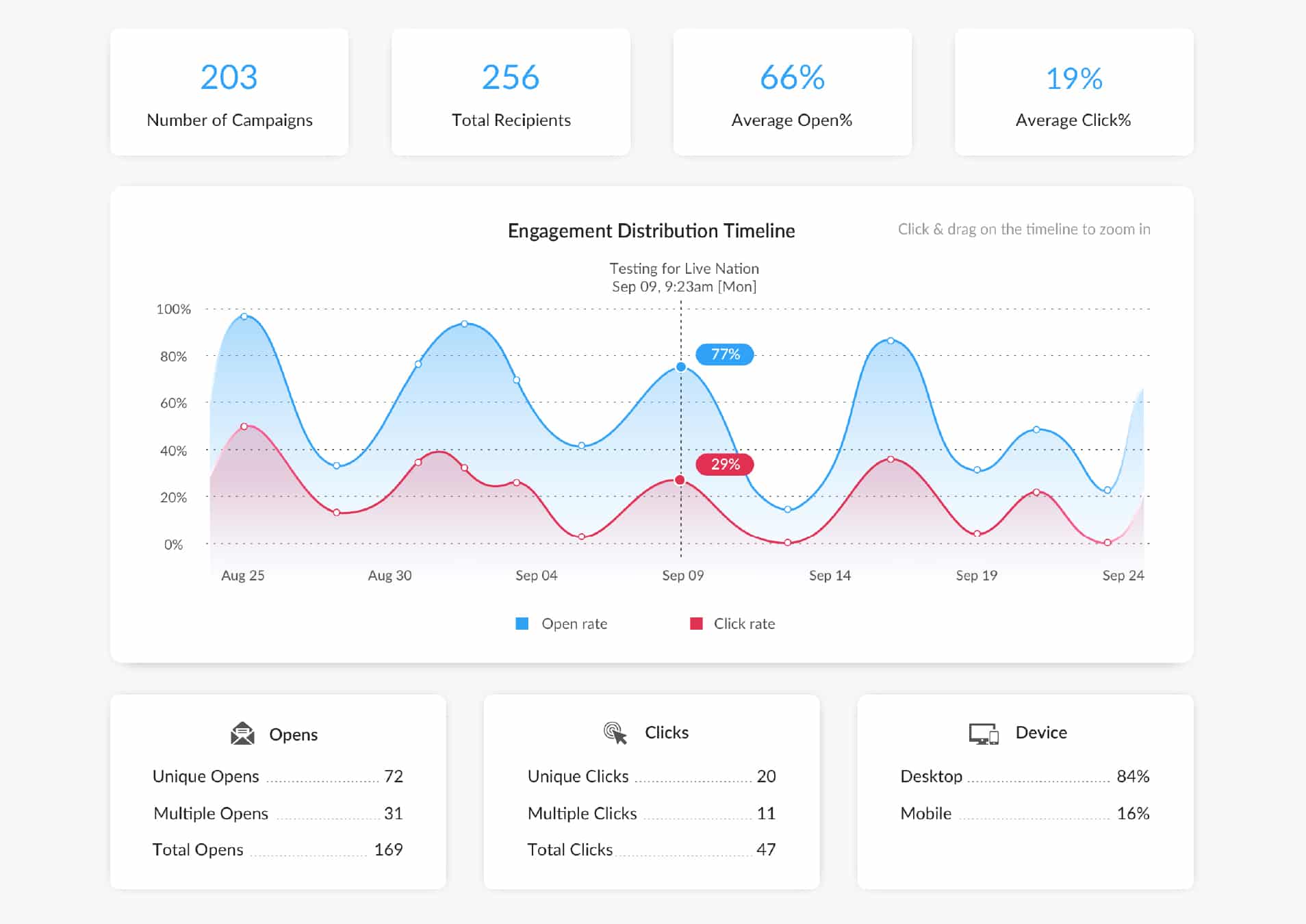
How to Analyze and Interpret Employee Engagement Survey Results
Once your survey responses start rolling in, you’ll need to have a strategy for analyzing your employee survey results. In general, it’s best to start by organizing your data.
Numerical data should be organized into a table or graph. Written insights, such as employee comments, can be organized by themes, such as work/life balance, compensation, and culture.
Once you have your data displayed and organized in a way that makes sense, start taking notes. Jot down any trends, patterns, or anomalies.
For instance, say you’re doing a sweeping assessment of engagement across your company. If you notice that one department has a higher engagement rate than others, you may want to zero in on what distinguishes them.
What sort of engagement drivers did team members highlight in their survey? How did they rate their management communications?
Answering these questions will help you create an informed employee engagement survey results action plan.
Analyze survey results faster with ContactMonkey
Use a pulse survey tool like ContactMonkey to take the hassle out of employee engagement survey analysis. ContactMonkey visualizes your survey data within your own analytics dashboard. Here you can track employee survey results from email campaigns and read employee comments.
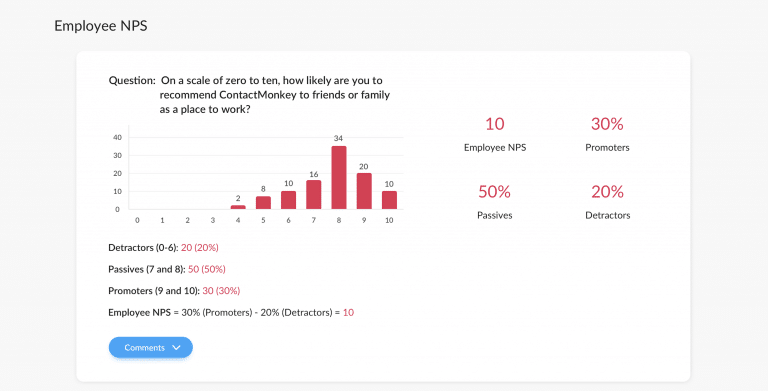
Employee Engagement Survey Results Action Plan
Once you’re able to figure out where employee engagement opportunities and challenges lie, you can begin to develop an action plan. This report should include key takeaways from your survey and your top recommendations, based on data.
To gather more valuable insights, it’s best to monitor employee engagement survey data over time before creating your action plan. This way, you can see what may have changed in your company and how it impacted employee engagement levels.
How to Communicate and Share Employee Engagement Survey Results
You will want to communicate your employee engagement survey results to two groups: employees and senior leaders.
Communicating survey results to employees
Showing your employees that you value their input and take their feedback seriously will encourage them to continue sharing. The best way to communicate your employee engagement survey results to employees is by highlighting how you plan to act on the feedback.
For instance, say your employees asked for more flexible work opportunities as a way to increase employee engagement. You decide to act on this feedback by introducing a hybrid work policy.
Use your employee newsletter to announce the initiative and how it came about as a result of employee feedback. Then thank employees for their input. This will encourage them to offer feedback again in the future because they see it makes a difference.
Communicating survey results to company leaders
When sharing employee engagement feedback with senior leaders, you’ll need to provide a clear breakdown of the data. You’ll also want to outline what the analytics suggest and your recommendations for improving employee engagement.
For instance, maybe your employee feedback data reveals that staff want more consistent and regular communications. Your recommendations may include investing in new communications tools or planning more virtual team-building activities. In this case, you’ll need to build a business case for internal communications software using your data.
Build a business case for internal communications software with ContactMonkey
Use ContactMonkey’s employee engagement survey tool to show your team the ROI on employee engagement. With ContactMonkey’s survey analytics dashboard, you can easily export and share your survey results in either PDF or PowerPoint format.
How to Improve Employee Engagement Survey Results with ContactMonkey
Employee engagement surveys offer a data-based approach for engaging your workforce. They help you measure, monitor, and understand workplace engagement, and give you the insights to improve it.
When you have a clear picture of where your engagement efforts are succeeding or falling behind, you can make better decisions about what needs to change. You can also easily demonstrate employee engagement ROI by having solid data to point to.
By letting you embed and track pulse surveys from your internal newsletters, ContactMonkey makes it easy to measure and improve employee engagement. Book your free demo to see ContactMonkey in action today.